Expert’s Rating
Pros
- High brightness in SDR and HDR
- Excellent color performance
- Sturdy yet compact stand
- Wide range of connectivity including USB-C
Cons
- USB-C Power Delivery is just 15 watts
- HDR mode is not good
- Expensive for a 32-inch, 1440p monitor
Our Verdict
The Dell G3223D is a big 1440p monitor with vivid color and USB-C connectivity. The 165Hz refresh rate and broad compatibility will appeal to gamers while the excellent image quality works well even for creators. However, if HDR is important to you, it’s best to look elsewhere.
Price When Reviewed
479.99
Best Prices Today: Dell G3223D

$479.99
Free

$479.99
Want a big monitor with a long list of features but a mid-range price tag? Dell’s G3223D stands out. This 1440p gaming monitor has USB-C, a 165Hz refresh rate, and four video inputs, all for $499. It delivers great image quality in most situations. Just leave off the HDR mode.
Dell G3223D: The specs
The Dell G3223D’s connectivity is the headline feature. It has a USB-C port with DisplayPort Alternate Mode that can handle the monitor’s maximum refresh rate of 165Hz. This is unusual for a gaming monitor. Dell also throws in official support for both AMD FreeSync Premium and Nvidia G-Sync.
- Display size: 32-inch
- Native resolution: 2560×1440
- Panel type: IPS
- Refresh rate: Up to 165Hz
- Adaptive sync: AMD FreeSync Premium and G-Sync Compatible
- Ports: 2x HDMI 2.0, 1x DisplayPort, 1x USB-C with DIsplayPort Alternate Mode and 15 watts Power Delivery, 2x downstream USB-A, 3.5mm audio out
- Stand adjustment: Height, tilt, swivel
- VESA mount: Yes, 100x100mm
- Speakers: None
- Price: $719 MSRP, around $480 street
The monitor’s approximate $480 price is on the high side for a 32-inch 1440p monitor. Alternatives like Samsung’s Odyssey G5 and Monoprice’s Dark Matter 32-inch are more than $100 less expensive. The Dell’s performance largely justifies the price, but only if you can scratch HDR off your list of needs.
Dell G3223D: Design
The Dell G3223D uses the design language now common to the company’s entry-level and mid-range gaming monitors. It’s a subdued collection of matte-black plastic, though a few vents on the monitor’s rear make its gaming aspirations clear.
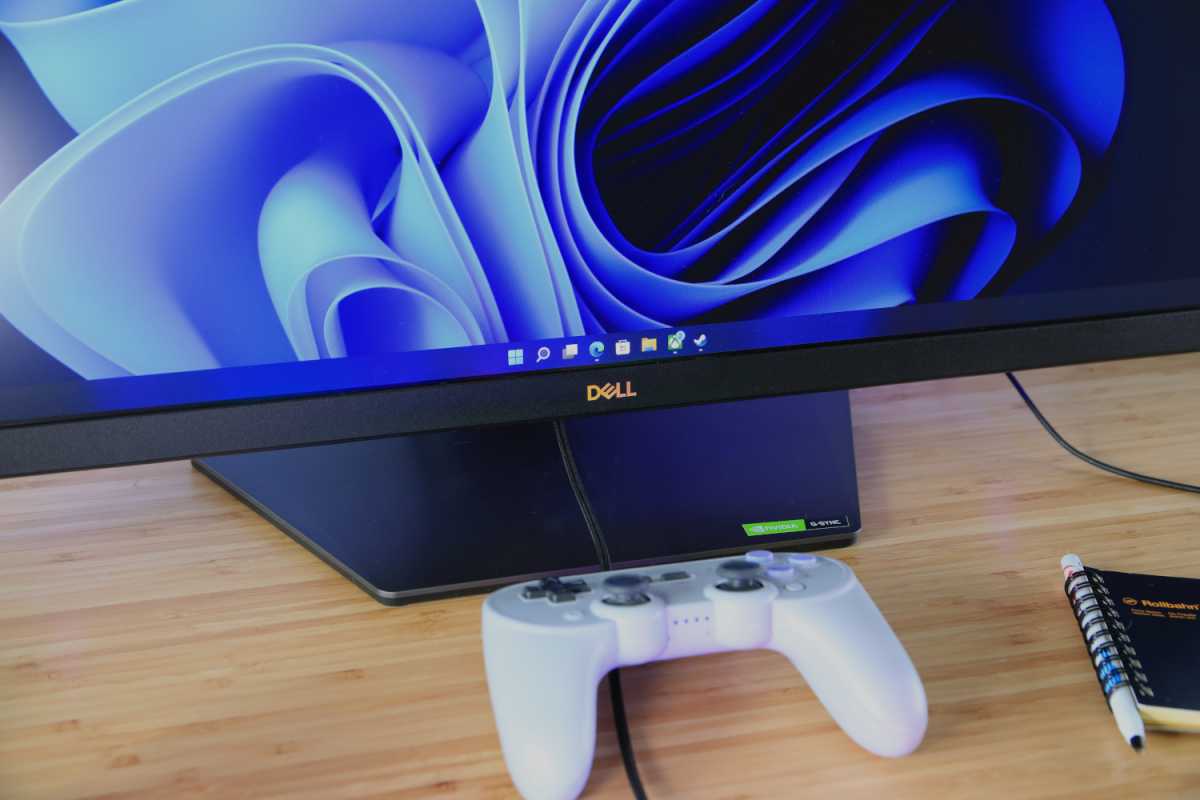
A simple but solid design with quality matte-black plastic.
Matt Smith
Though not bold, Dell’s use of quality materials adds up to a more handsome and cohesive look than most competitors. Alternatives from LG, Gigabyte, Acer, and Asus tend to feel flimsy by comparison—in this price range, at least.
The monitor’s stand is excellent. It’s hefty and keeps vibration to a minimum if you accidentally bump your desk. Ergonomic adjustment includes height, swivel, and tilt, but the display can’t pivot into portrait mode. A 100x100mm VESA monitor mount is available for adding a third-party stand or arm.
Dell’s stand also has a flat base that consumes much less desk space than the wider stands on gaming monitors from BenQ, Samsung, and Dell’s own Alienware brand.
Dell G3223D: Features and menu
Dell markets the G3223D as a USB-C gaming monitor. This remains an unusual feature in the gaming monitor space despite the proliferation of USB-C and its ability to handle high refresh rates over USB-C using the available DisplayPort Alternate Mode. USB-C can be a handy way to connect high-end gaming laptops like Razer’s Blade line.
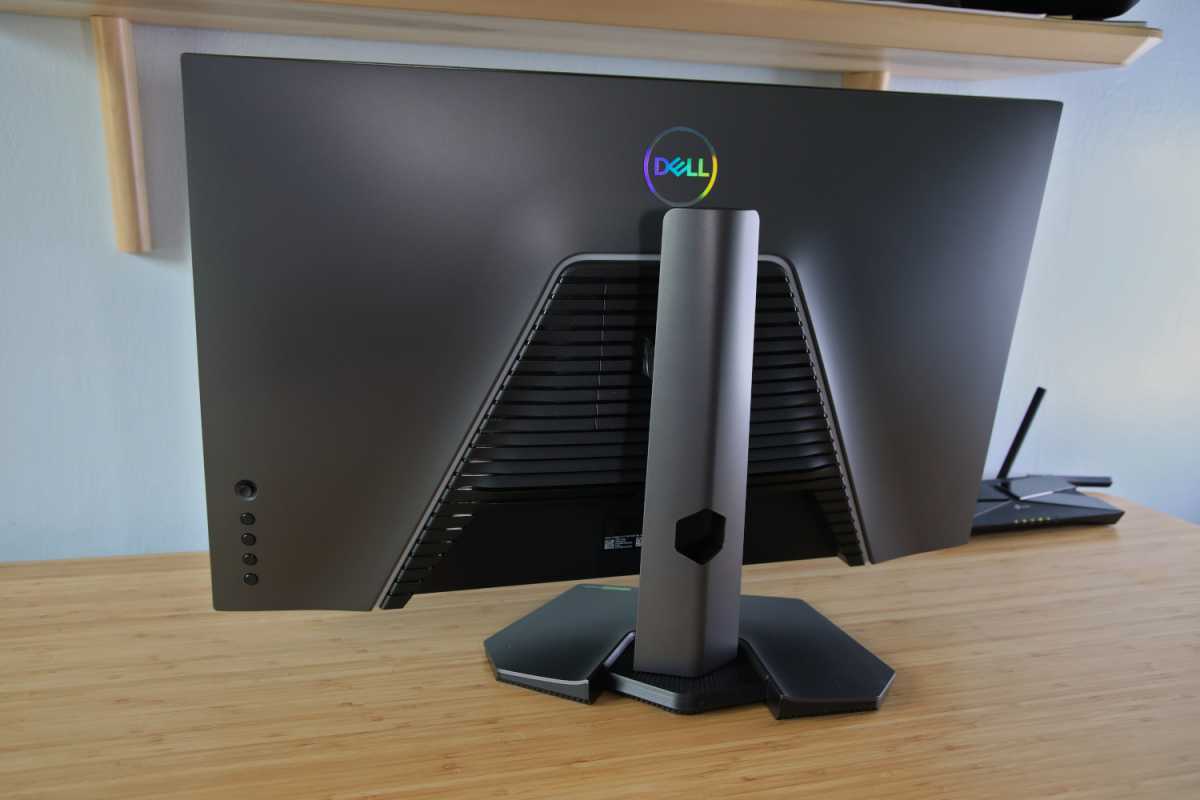
Plenty of ports offer broad compatability and USB-C connectivity.
Matt Smith
This is not a USB-C hub monitor, however. It only provides 15 watts of USB-C Power Delivery, which is nowhere near enough to charge a laptop while it’s in use, and has only two USB-A ports for connecting wired peripherals.
USB-C aside, the monitor has two HDMI 2.0 ports and a DisplayPort 1.4 port. This puts the total number of video inputs at four, which is excellent for a monitor in this price range. That’s good news if you have many devices to connect. The HDMI 2.0 ports can only handle a refresh rate of up to 144Hz, but I doubt most owners will find this an issue.
Monitor control is easy thanks to a joystick input and well-defined tactile buttons. Dell’s monitor menu system remains among the most intuitive in the business. Users who want to tune the monitor can access a dedicated sRGB mode or a custom color mode that has RGB gain, offset, hue, and saturation settings. Dell doesn’t provide precise gamma or color temperature presets, however, which could be annoying for creators.
Gamers can access a variety of gaming-specific extras. These include a black equalizer, which brightens dark scenes to make opponents easy to spot, and a crosshair for games or situations that lack one built-in. There’s also a zoom mode, a refresh rate counter, and a smattering of other extras. I wouldn’t call these essential, but they’re good to see on a monitor marketed to gamers.
A word of warning: The G3223D does not include speakers. You will need external speakers or a headset.
Dell G3223D: SDR image quality
The Dell G3223D carries a mid-range price for a monitor of its size, but it comes out swinging in image quality. It can come close to more expensive displays in many areas but, like many 32-inch monitors, it’s weak in contrast.
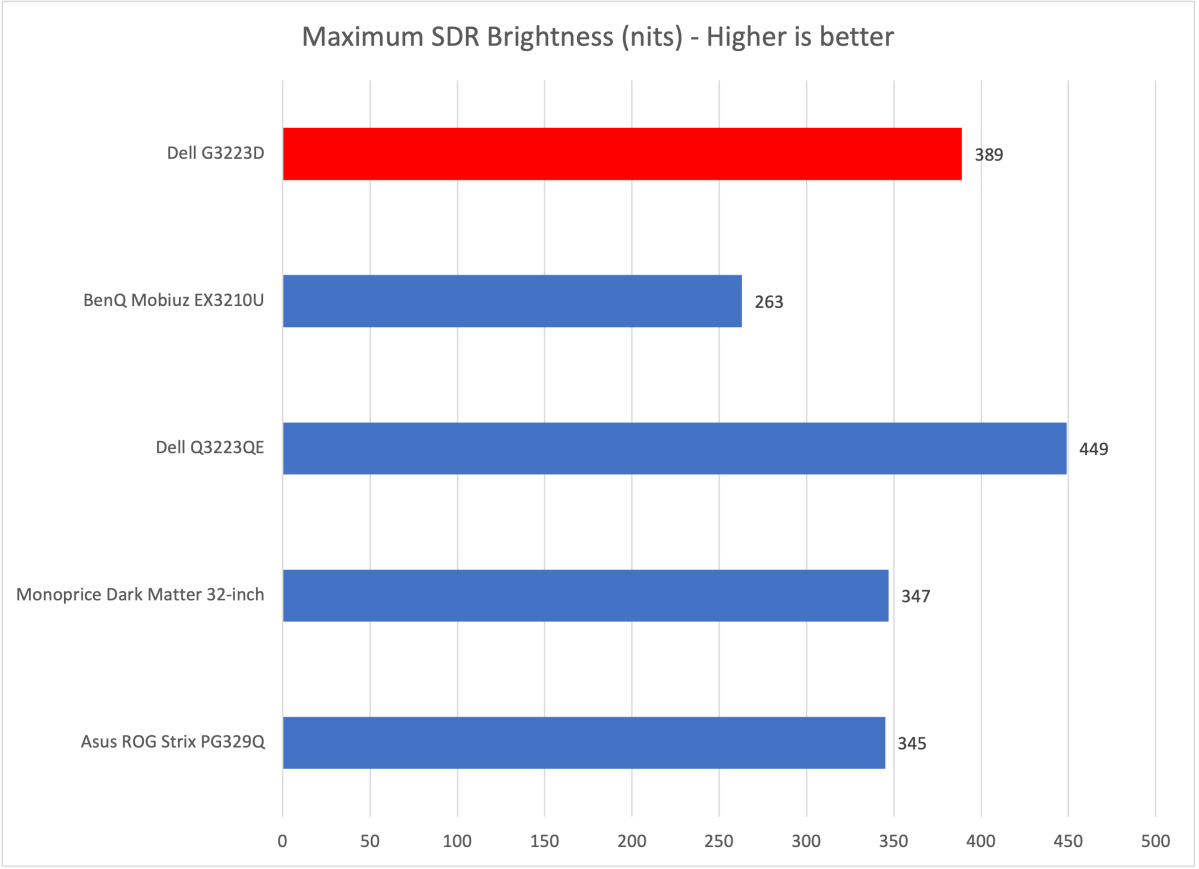
Matt Smith
Maximum SDR brightness comes in at 389 nits. This is a good result that is competitive with or better than most 32-inch monitors on the market. Most owners will want to turn down the brightness, as it can be uncomfortable over long sessions in a dim room, but those working in a sunny space will appreciate the added oomph.
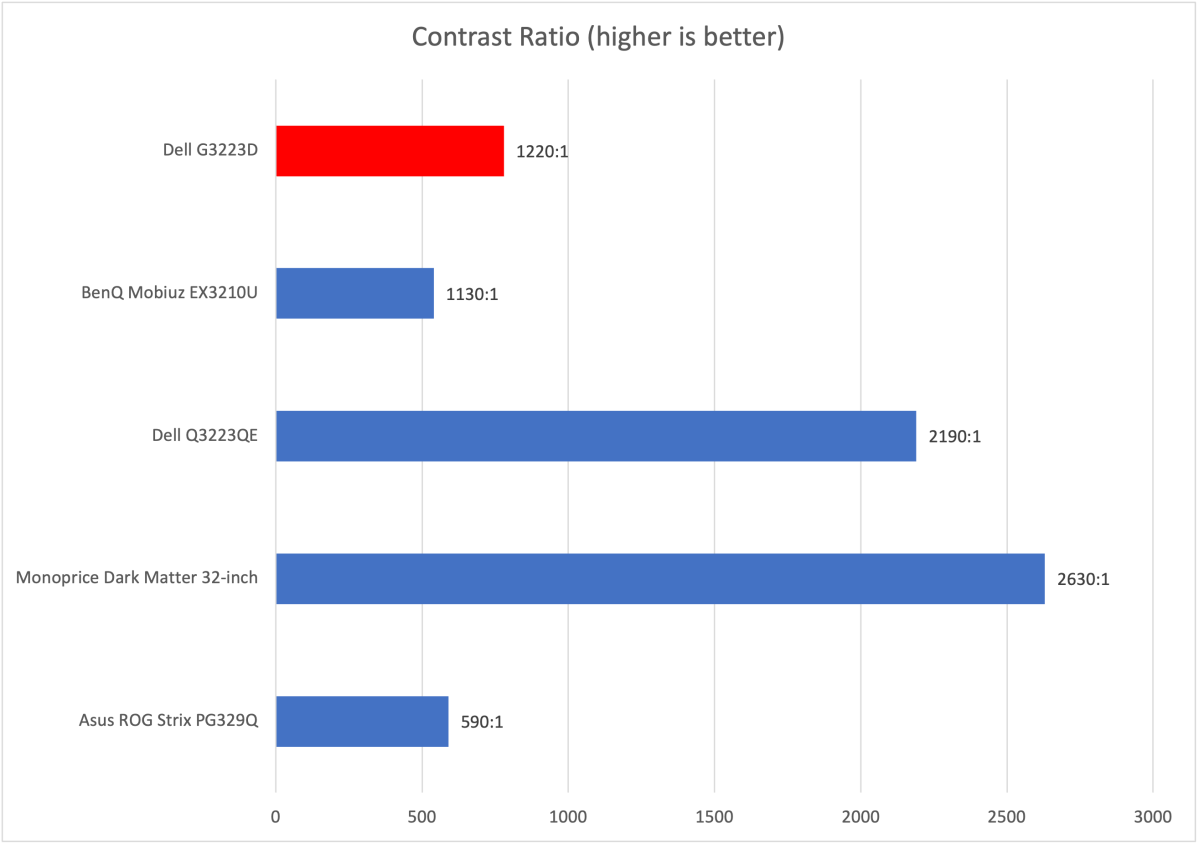
Matt Smith
The G3223D turns in a modest maximum contrast ratio of 780:1. This is not a great result, falling way short of new IPS Black monitors like the Dell U3223QE and VA panel monitors like the Monoprice Dark Matter 32-inch. Disappointing black-level performance is the G3223D’s biggest issue, sapping depth and dimensionality from moody scenes.
However, the G3223D beats several more expensive monitors like the BenQ EX3210U and Asus ROG Strix PG329Q. These 4K alternatives are sharper but have a lot of trouble with dark, contrast-rich scenes. This goes to show a higher price doesn’t guarantee superior performance.
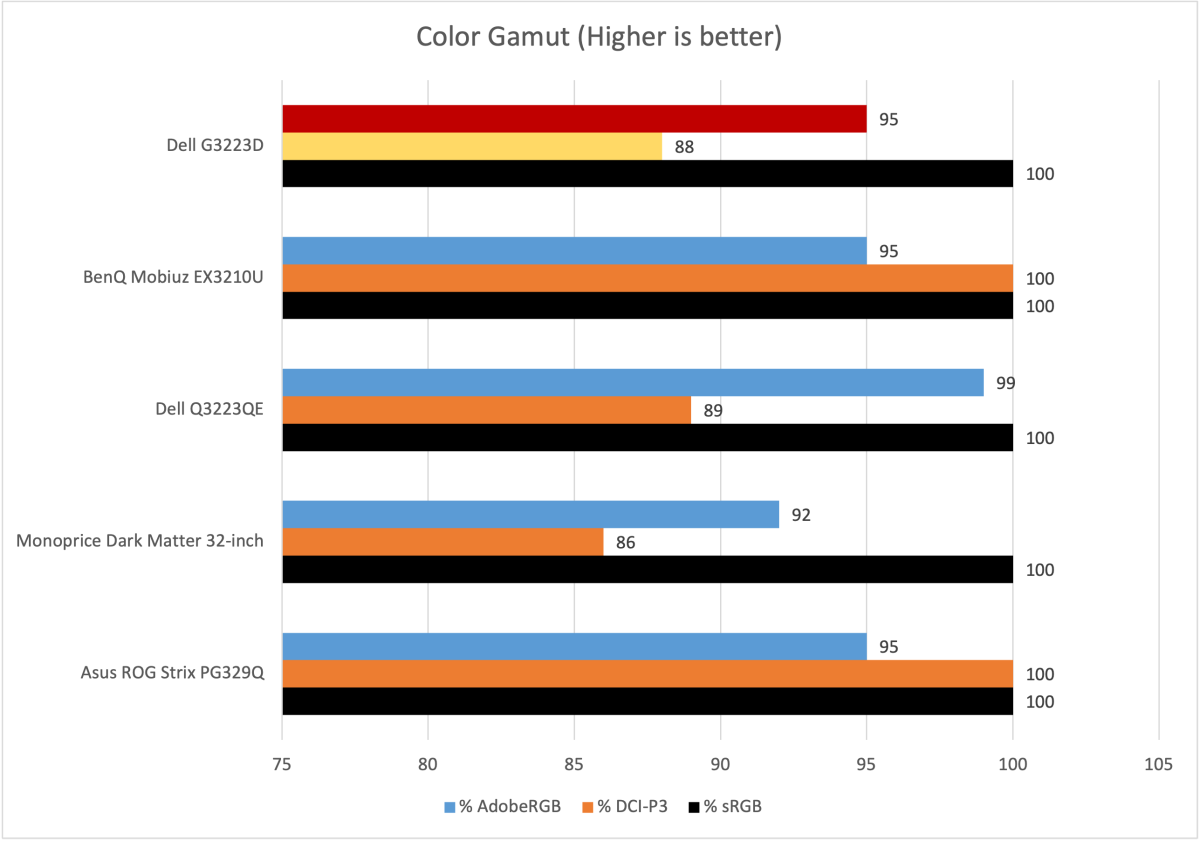
Matt Smith
Color gamut comes in at 100 percent of sRGB and 95 percent of DCI-P3. This color space is wide enough to be called “wide gamut,” in my opinion. Colors look noticeably more saturated and deliver more punch compared to monitors that display less of the DCI-P3 gamut.
The G3223D’s coverage of DCI-P3 is far from the best available, so creators serious about getting colors right will likely want to skip this monitor. If you mostly create for Twitch or YouTube, however, this monitor is good enough.
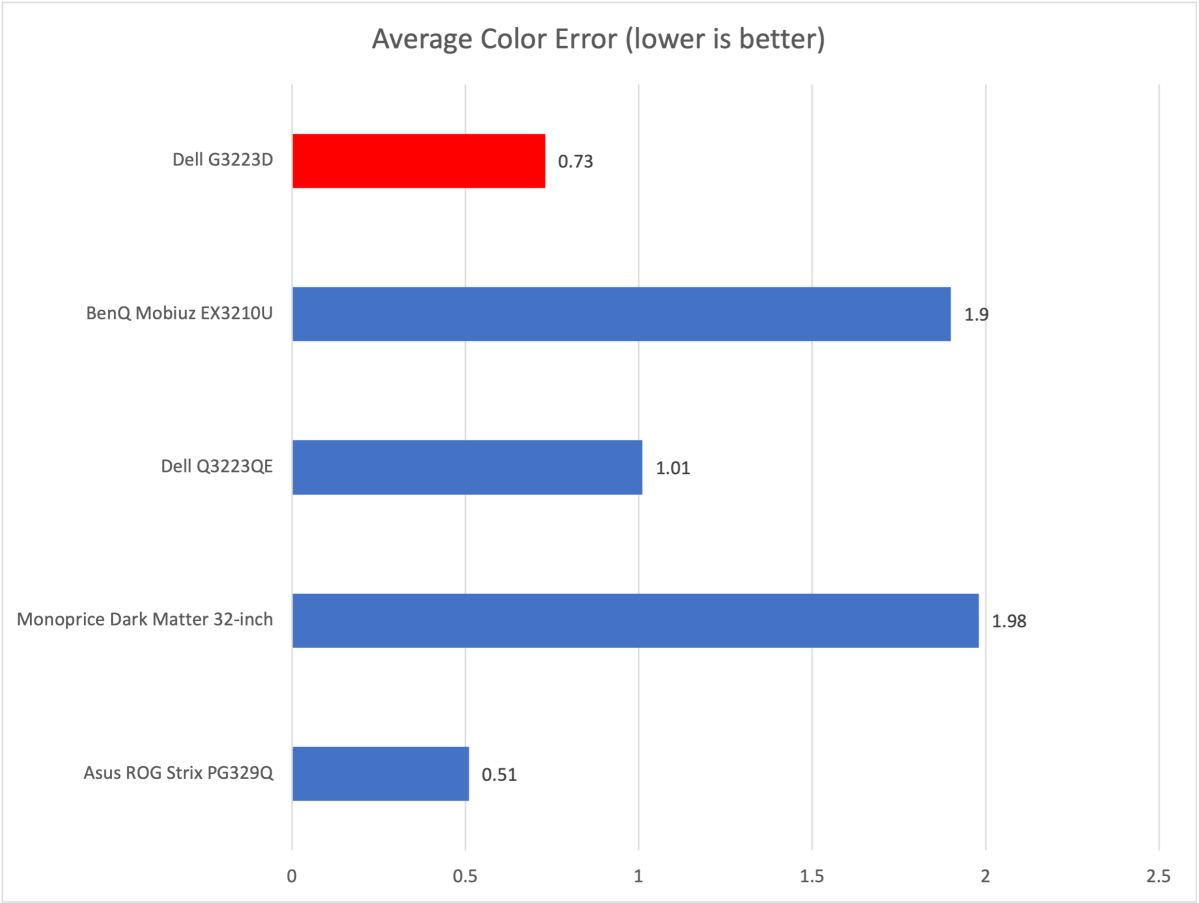
Matt Smith
Accuracy is a major strength. The G3223D came out of the box with an exceptionally low average color error, a spot-on gamma curve of 2.2, and an ideal color temperature of 6500K.
This means content looks realistic and lifelike though, in some cases, it can appear oversaturated due to the wide color gamut. Bright, vivid content—whether it’s a Pixar movie or Valorant—looks exceptional for a mid-range monitor.
Sharpness is less impressive. The G3223D offers 2560×1440 resolution, which works out to about 92 pixels per inch across the 32-inch display. Smaller fonts can look pixelated and sharp edges in games will show distracting shimmer in motion, especially if the game’s anti-aliasing is subpar.
Though not perfect, the G3223D is a solid SDR performance. It’s especially good in games and animated shows, as this content tends to make the lack of sharpness less obvious and leans on its strengths in color performance and brightness.
Dell G3223D: Motion clarity
Official adaptive sync support comes through both AMD FreeSync Premium Pro and Nvidia G-Sync. It’s good to see Dell embrace Nvidia compatibility. Many competitors don’t, despite Nvidia being the most popular discrete graphics option.
Refresh rates rise as high as 165Hz over DisplayPort. This includes the USB-C port’s DisplayPort Alternate Mode. The HDMI ports can only hit 144Hz, but this is close enough to the maximum refresh rate that I don’t consider it a significant issue. Motion clarity, though not unusually good for a monitor of this type, is great at both 144Hz and 165Hz.
A note of caution to PlayStation gamers: This is a 1440p monitor and, as such, it’s not a good match for the PlayStation 5. The PlayStation 5 does not support 1440p resolution, so you’ll only be able to access 1080p at up to 120Hz. The Xbox Series X and S do support 1440p resolution at up to 120Hz, so it’s not a problem for Xbox fans.
Final thoughts
The Dell G3223D is a strong pick for those seeking a big monitor with many features at a reasonable price. Though marketed for gamers, the G3223D performs well enough to work as a monitor for creators, and its high brightness and good color makes for enjoyable day-to-day use. A wide range of video connectivity that includes USB-C only sweetens the deal.
Mediocre contrast and a deeply disappointing HDR mode are the monitor’s flaws. Not everyone will find these to be a problem, but they’re sure to disappoint if you want to hook up an HDR-capable game console or enjoy watching HDR movies. If these features are unimportant to you, however, the G3223D is a good choice.




